Printing the Paper Negative
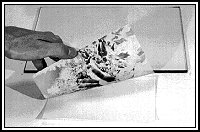 When
we show a photograph to others, we are showing a print of the original photograph,
which is a negative. Fortunately, it is easy to make prints from our negatives. As shown
here, simply make a sandwich of the negative (always on top) and an unexposed piece of
"paper film" (always on the bottom). Be certain that the light-sensitive side of
the unexposed photographic paper is facing up, or you will not get a print but will
ruin a sheet of paper. Remember, the light-sensitive side (called the "emulsion"
side) of the photographic paper is more shiny than the back, and if touched with a damp
finger, will feel sticky. Place the plate glass over the sandwich to hold the two sheets
of paper in tight contact with each other, and expose with light from the 15w. bulb held
about three feet above the glass for a couple of seconds. Count the seconds because, if
the first print is too light, you will have to try again using a longer exposure time. If
the first print develops quickly and becomes too dark, make another print using less
exposure time. What happens when making a print (called a "contact print" when
done this way) is that light passes through the light areas of the negative, exposing the
paper below. When developed, those areas become dark. Dark areas of the negative block the
light, so the corresponding areas on the print develop to be light. You are making a
"negative" print of a "negative" from the camera, so the end result is
a negative of a negative, or a positive, a photographic print. Thousands of prints
can be made from a negative, but there can only be one original "negative"
photograph actually exposed inside the pinhole camera. Take care of your negatives, for
each is unique, truely one-of-a-kind.
When
we show a photograph to others, we are showing a print of the original photograph,
which is a negative. Fortunately, it is easy to make prints from our negatives. As shown
here, simply make a sandwich of the negative (always on top) and an unexposed piece of
"paper film" (always on the bottom). Be certain that the light-sensitive side of
the unexposed photographic paper is facing up, or you will not get a print but will
ruin a sheet of paper. Remember, the light-sensitive side (called the "emulsion"
side) of the photographic paper is more shiny than the back, and if touched with a damp
finger, will feel sticky. Place the plate glass over the sandwich to hold the two sheets
of paper in tight contact with each other, and expose with light from the 15w. bulb held
about three feet above the glass for a couple of seconds. Count the seconds because, if
the first print is too light, you will have to try again using a longer exposure time. If
the first print develops quickly and becomes too dark, make another print using less
exposure time. What happens when making a print (called a "contact print" when
done this way) is that light passes through the light areas of the negative, exposing the
paper below. When developed, those areas become dark. Dark areas of the negative block the
light, so the corresponding areas on the print develop to be light. You are making a
"negative" print of a "negative" from the camera, so the end result is
a negative of a negative, or a positive, a photographic print. Thousands of prints
can be made from a negative, but there can only be one original "negative"
photograph actually exposed inside the pinhole camera. Take care of your negatives, for
each is unique, truely one-of-a-kind.
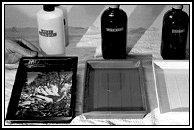
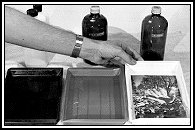
After exposing the contact print,
develop, stop bath, and fix it exactly as you did with the original paper film from the
camera. Wash and dry the print the same way, too. It is convenient that the same
photographic paper can be used both as "paper film" inside the camera to produce
negatives, and to make contact prints from the negative originals. Another word for a
contact print is a "photograph", or a "picture". Or, an
"oatmeal-box pinhole camera picture!"
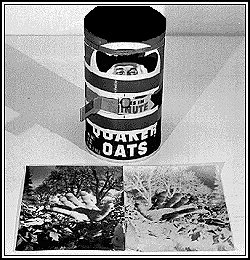
Isn't it amazing what an oatmeal box can
do? Here are the positive print and original "paper film" negative of my hand
sticking out from a pile of leaves. I prefer the oatmeal box as a camera because of the
wide-angle effect it gives its pictures. Actually, a pinhole camera can be constructructed
from almost any light-tight box. A square shaped camera body will give "normal"
looking pictures. But even "normal" pinhole photographs usually have an air of
mystery about them. I close with a photo which captures oatmeal-box pinhole photography
and how people look at you when you are out making pictures with an oatmeal box!
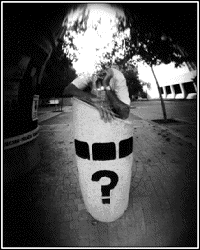
Oatmeal-Box Pinhole
Photographer
...Stewoody...


Back Home
 When
we show a photograph to others, we are showing a print of the original photograph,
which is a negative. Fortunately, it is easy to make prints from our negatives. As shown
here, simply make a sandwich of the negative (always on top) and an unexposed piece of
"paper film" (always on the bottom). Be certain that the light-sensitive side of
the unexposed photographic paper is facing up, or you will not get a print but will
ruin a sheet of paper. Remember, the light-sensitive side (called the "emulsion"
side) of the photographic paper is more shiny than the back, and if touched with a damp
finger, will feel sticky. Place the plate glass over the sandwich to hold the two sheets
of paper in tight contact with each other, and expose with light from the 15w. bulb held
about three feet above the glass for a couple of seconds. Count the seconds because, if
the first print is too light, you will have to try again using a longer exposure time. If
the first print develops quickly and becomes too dark, make another print using less
exposure time. What happens when making a print (called a "contact print" when
done this way) is that light passes through the light areas of the negative, exposing the
paper below. When developed, those areas become dark. Dark areas of the negative block the
light, so the corresponding areas on the print develop to be light. You are making a
"negative" print of a "negative" from the camera, so the end result is
a negative of a negative, or a positive, a photographic print. Thousands of prints
can be made from a negative, but there can only be one original "negative"
photograph actually exposed inside the pinhole camera. Take care of your negatives, for
each is unique, truely one-of-a-kind.
When
we show a photograph to others, we are showing a print of the original photograph,
which is a negative. Fortunately, it is easy to make prints from our negatives. As shown
here, simply make a sandwich of the negative (always on top) and an unexposed piece of
"paper film" (always on the bottom). Be certain that the light-sensitive side of
the unexposed photographic paper is facing up, or you will not get a print but will
ruin a sheet of paper. Remember, the light-sensitive side (called the "emulsion"
side) of the photographic paper is more shiny than the back, and if touched with a damp
finger, will feel sticky. Place the plate glass over the sandwich to hold the two sheets
of paper in tight contact with each other, and expose with light from the 15w. bulb held
about three feet above the glass for a couple of seconds. Count the seconds because, if
the first print is too light, you will have to try again using a longer exposure time. If
the first print develops quickly and becomes too dark, make another print using less
exposure time. What happens when making a print (called a "contact print" when
done this way) is that light passes through the light areas of the negative, exposing the
paper below. When developed, those areas become dark. Dark areas of the negative block the
light, so the corresponding areas on the print develop to be light. You are making a
"negative" print of a "negative" from the camera, so the end result is
a negative of a negative, or a positive, a photographic print. Thousands of prints
can be made from a negative, but there can only be one original "negative"
photograph actually exposed inside the pinhole camera. Take care of your negatives, for
each is unique, truely one-of-a-kind.




